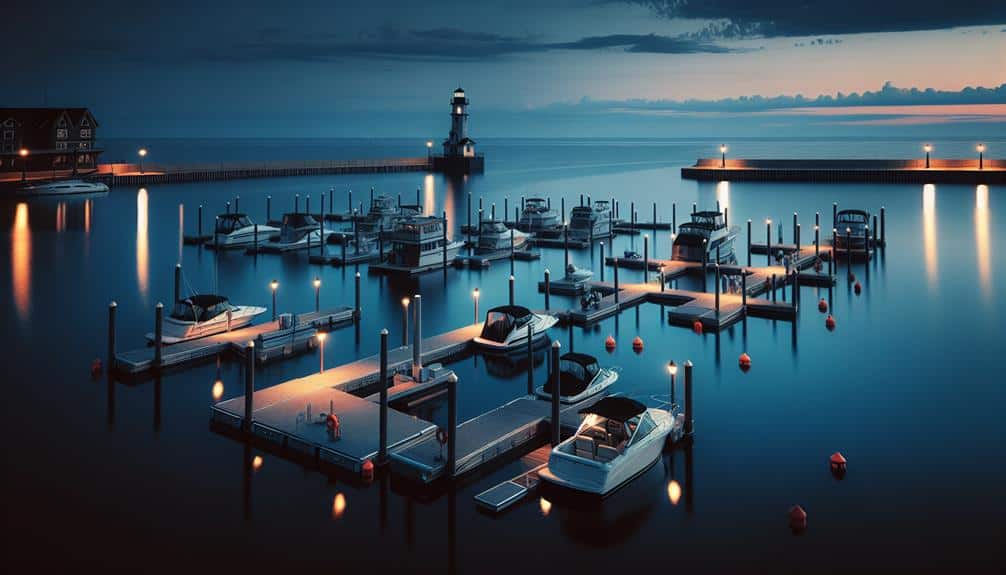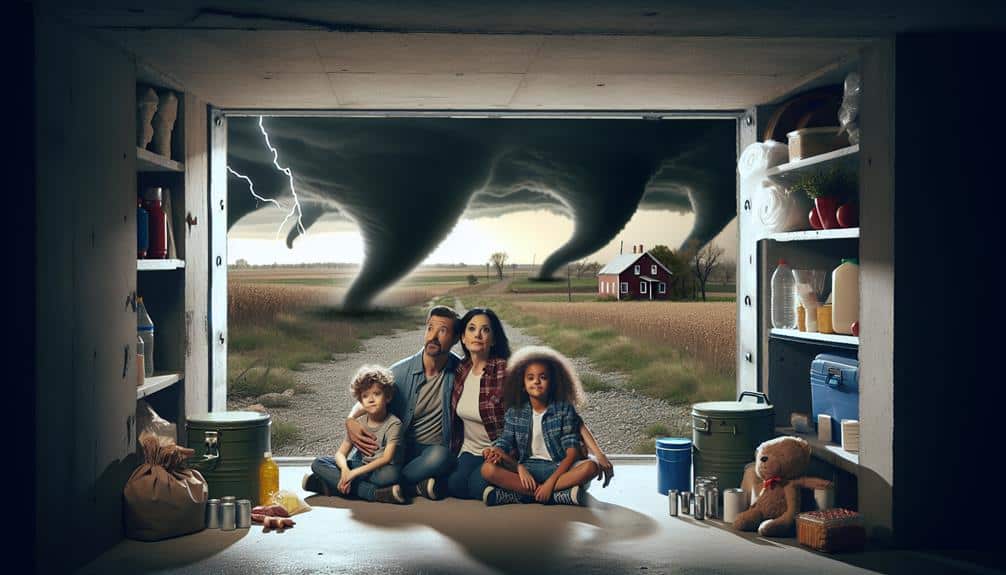When deciding where to shelter during a storm, we have several excellent options. Marinas offer secure docking and essential services. Natural harbors and coastal caves provide natural protection against high winds. Boat basins and inland lakes shield us from waves, while river mouths serve as calm havens. Floating docks near protected inlets are also a smart choice. Each location offers unique benefits to keep us safe and our boats secure. You'll find deeper insights into these havens just below.
Key Points
- Marinas offer secure docking with reinforced docks and essential services during storms.
- Natural harbors provide protection with coastal cliffs and hidden coves.
- Boat basins shield vessels from storm-driven surges and offer secure docking facilities.
- Coastal caves act as natural wind barriers nestled within secluded bays and coves.
Marinas
Marinas are crucial storm shelters for boaters, offering secure docking facilities and essential services to protect vessels during severe weather. When storms threaten, we must prioritize finding a marina equipped with the necessary infrastructure to safeguard our boats. Most marinas provide robust mooring options and reinforced docks designed to withstand high winds and rough waters.
In addition to physical protection, marinas are often stocked with emergency supplies. We can find everything from extra lines and fenders to fuel and first aid kits. These supplies can be lifesaving when the weather takes a turn for the worse. Knowing that these resources are readily available allows us to focus on securing our vessels without the added stress of scrambling for essentials.
Safety protocols are another crucial aspect that sets marinas apart as storm shelters. Many marinas have well-established guidelines for storm preparedness, including communication systems to alert boaters of impending weather changes. Staff are typically trained to assist with emergency procedures, such as securing boats and evacuating if necessary. By adhering to these protocols, we enhance our safety and that of our fellow boaters, ensuring a communal effort in weathering the storm.
Natural Harbors
Natural harbors offer a valuable alternative for boaters seeking shelter from storms, providing naturally occurring protection against high winds and rough seas. These harbors are often surrounded by coastal cliffs or nestled within hidden coves, creating a natural defense that can be as effective as man-made structures.
When we find ourselves caught in a sudden storm, a natural harbor can be a lifesaver. Remote islands often feature secluded bays that serve as excellent storm shelters. These bays are usually shielded from the brunt of the storm's force, thanks to their geological formations. The surrounding landmasses break up wind patterns and reduce wave intensity, offering a safer haven for our vessels.
By anchoring in these secluded spots, we can minimize the risk of damage while waiting out the storm. It's essential to be familiar with the geography of our cruising grounds. Knowing the locations of these natural shelters can make all the difference when the weather takes a turn for the worse.
Natural harbors provide us with the freedom to explore the open water while still having reliable options for safety. So, let's make the most of these natural havens and navigate with confidence.
Boat Basins
Boat basins offer us excellent protection from waves and turbulent waters during storms. They provide secure docking facilities that keep our vessels safe and steady.
Additionally, we can access nearby amenities, making these locations highly convenient during inclement weather.
Shelter From Waves
When seeking sanctuary from turbulent waters, we often turn to well-constructed boat harbors that provide essential protection against relentless waves. These harbors, designed with wave shielding in mind, shield our vessels from the punishing impact of storm-driven surges. By choosing a harbor with reinforced breakwaters and ample space, we reduce the risk of damage to our boats.
To maximize our safety, we need to follow some essential safety tips. First and foremost, always check the structural integrity of the harbor before mooring. Look for signs of wear or damage that might jeopardize wave protection. In addition, familiarize ourselves with local storm preparation protocols. Knowing the procedures in place can save crucial time and effort when a storm is imminent.
Having a well-crafted emergency plan is vital. This plan should include designated shelter locations, contact information for emergency services, and a checklist of necessary supplies and equipment. We must regularly review and practice this plan to guarantee we can execute it effectively under pressure.
Staying informed and prepared is the key to successfully handling unpredictable weather. By utilizing boat harbors with robust wave protection and following strategic storm preparation, we can safeguard both our vessels and our sense of freedom on the open water.
Secure Docking Facilities
In addition to harbors, we must also consider secure docking facilities, or boat basins, which play a vital role in protecting our vessels from severe weather conditions. These basins are designed to provide maximum docking safety, offering sturdy moorings that can withstand high winds and rough waters. When selecting a boat basin, we should look for those with reinforced docks, breakwaters, and ample space to maneuver our boats safely.
Docking safety isn't just about the physical infrastructure; it's also about the procedures we follow. In an emergency, knowing the layout of the basin and the locations of emergency equipment like fire extinguishers and life rings is essential. We should familiarize ourselves with the basin's emergency procedures, ensuring that all crew members are briefed and ready to act swiftly if the need arises.
Moreover, secure boat basins often have staff trained in emergency response, ready to assist us in securing our vessels and offering guidance during the storm. Choosing a well-managed facility means we're not just relying on robust structures but also on experienced personnel dedicated to our safety.
Accessible Amenities Nearby
Having nearby amenities significantly improves the convenience and comfort of any secure boat basin. When seeking shelter from a storm, being close to nearby eateries and grocery stores can make all the difference. It's clear that after securing our vessel, the next priority is making sure we've access to essential supplies and services.
Close-by restaurants offer a variety of dining choices, allowing us to enjoy a warm meal without the inconvenience of cooking on board. This is particularly valuable when weather conditions make food preparation difficult. A variety of culinary options also means we can indulge in different cuisines, enhancing our stay and reducing stress.
Grocery stores in the area are equally important. They enable us to swiftly restock our provisions, whether it's fresh produce, bottled water, or other essentials. Having a well-supplied store nearby guarantees that we can comfortably weather the storm without concerns about running out of necessary items.
These accessible amenities not only increase convenience but also contribute to our peace of mind. Knowing that we can easily obtain food and supplies allows us to concentrate on the safety and protection of our vessel and ourselves.
Coastal Caves
When we face a sudden storm, coastal caves offer excellent natural wind protection that can be vital for our safety.
These hidden safe havens provide a secure spot to wait out harsh weather conditions.
Natural Wind Protection
Coastal caves offer boaters a natural refuge from strong winds, providing a sheltered haven during turbulent weather. When we find ourselves moving through rough seas, these caves, often nestled within forested coves and secluded bays, can be a lifesaver. The protection they offer is unparalleled, as the rocky cliffs and hidden inlets act as natural barriers against gusty winds and high waves. By anchoring our boats in these strategic locations, we can wait out the storm in relative safety and comfort.
Our experience has taught us that the geography of these coastal caves plays an essential role in their effectiveness. The overhanging rock formations and enclosed nature of the caves reduce wind velocity and wave impact, making them ideal spots for sheltering. Additionally, the surrounding forested areas further disperse wind energy, adding another layer of protection. It's important, however, to make sure that the cave is deep enough and the entrance wide enough to accommodate our vessel.
While seeking out these natural sanctuaries, we must remain vigilant about tidal changes and potential underwater hazards. Coastal caves, with their combination of rocky cliffs and hidden inlets, offer a safe and secure option when the weather turns dangerous, allowing us the freedom to move with confidence.
Hidden Safe Haven
Exploring further, we discover that these coastal caves not only offer wind protection but also function as hidden safe havens, providing unparalleled security and peace of mind during storms. Nestled in remote islands and secluded coves, these natural formations are often overlooked, making them perfect undiscovered sanctuaries for those of us on the water.
As we navigate through hidden inlets, we can find these caves tucked away, shielded from the brunt of the storm's fury. Their natural structure provides a robust barrier against high winds and turbulent waves, ensuring that our vessels remain secure. The tranquility within these caves contrasts sharply with the chaos outside, offering a much-needed respite.
Furthermore, the seclusion of these coastal caves enhances our sense of freedom. Anchoring in a remote cave allows us to escape crowded marinas and busy ports, embracing the raw beauty and serenity of nature. These hidden safe havens aren't just practical; they enrich our boating experience by connecting us more deeply with the environment.
Inland Lakes

Locating inland lakes during turbulent weather requires knowing the safest storm shelter locations available. When we're on these inland waters, having detailed emergency plans in place is necessary.
One of our best strategies involves finding secluded coves. These natural formations offer protection from high winds and rough waters, providing a sanctuary where we can anchor down securely.
By identifying these coves in advance, we can act promptly when storms approach. Our emergency plans should always include multiple potential coves to ensure we've choices regardless of our exact location on the lake.
Equally significant are deep inlets. These areas often offer additional protection due to their depth and the natural barriers they present.
When considering deep inlets, we must follow strict safety precautions. It's vital to check local maps and be aware of any underwater hazards or shallow areas that could endanger our vessel's safety.
River Mouths
When traversing stormy conditions, river mouths offer another viable option for seeking shelter due to their natural protection from strong winds and waves. These locations, where rivers meet larger bodies of water, often create calm havens that can be lifesavers during a storm. We can anchor safely within these areas, shielded by the landscape's natural contours.
River mouths aren't just safe havens; they're also rich in activities once the storm passes. They often serve as prime fishing spots, teeming with diverse aquatic life. We can cast our lines and enjoy a peaceful day catching fish without venturing far from our safe shelter. Additionally, river mouths are excellent for wildlife watching. The unique ecosystems attract a variety of animals, making it perfect for those who enjoy bird watching. We might spot herons, eagles, or even ospreys hunting for fish.
For the adventurous souls, river mouths provide excellent kayaking opportunities. The calmer waters allow us to paddle through lush surroundings, explore hidden inlets, and experience the freedom of the open water.
Floating Docks

Floating docks offer boaters a reliable and flexible option for securing their vessels during stormy weather. Unlike fixed docks, floating docks rise and fall with the water levels, reducing the strain on the boat's moorings. This adaptability guarantees that our boats remain securely tethered even in turbulent conditions.
When selecting a floating dock, location is crucial. We should seek docks near protected inlets or marinas that provide additional shelter from high winds and waves. Many of these docks are conveniently situated near bustling waterfront restaurants, allowing us to enjoy a meal while waiting out the storm. It's vital to verify if the dock is well-maintained and has the necessary amenities, such as power hookups and sturdy cleats for mooring.
Another benefit of floating docks is their proximity to popular routes for sunset cruises. After the storm passes, we can easily shift from seeking shelter to enjoying the tranquil beauty of a post-storm sunset. The flexibility and convenience of floating docks make them an excellent choice for boaters who prioritize both safety and freedom.
Frequently Asked Questions
What Emergency Supplies Should Be Kept on Board During a Storm?
We should always keep emergency supplies like food storage, water purification tablets, first aid kits, flashlights, and extra batteries on board. These essentials guarantee we can stay safe and self-reliant during a storm at sea.
How Can I Quickly Secure Loose Items on My Boat Before a Storm Hits?
To quickly secure loose items, we should first focus on anchor preparation. Then, place smaller items in waterproof storage. Let's make sure everything is tightly fastened to prevent damage and maintain our freedom to navigate safely.
What Are the Signs of an Approaching Storm While at Sea?
Did you know that 70% of boating accidents happen due to unexpected weather? For storm preparation, we should focus on weather monitoring and navigation. Look for dark clouds, sudden wind changes, and falling barometric pressure to guarantee safety.
How Can I Communicate With Rescue Services if I Lose Power During a Storm?
If we lose power during a storm, we rely on our emergency communication backup plans. We follow safety protocols, use distress signals like flares or EPIRBs, and guarantee we're prepared for any situation to maintain our freedom.
What Is the Best Way to Anchor My Boat During a Severe Storm?
Did you know 80% of boats lost during storms aren't properly anchored? Using storm anchor techniques and boater safety strategies, we'll secure our boats with a heavy-duty anchor and at least 7:1 scope to guarantee safety.


